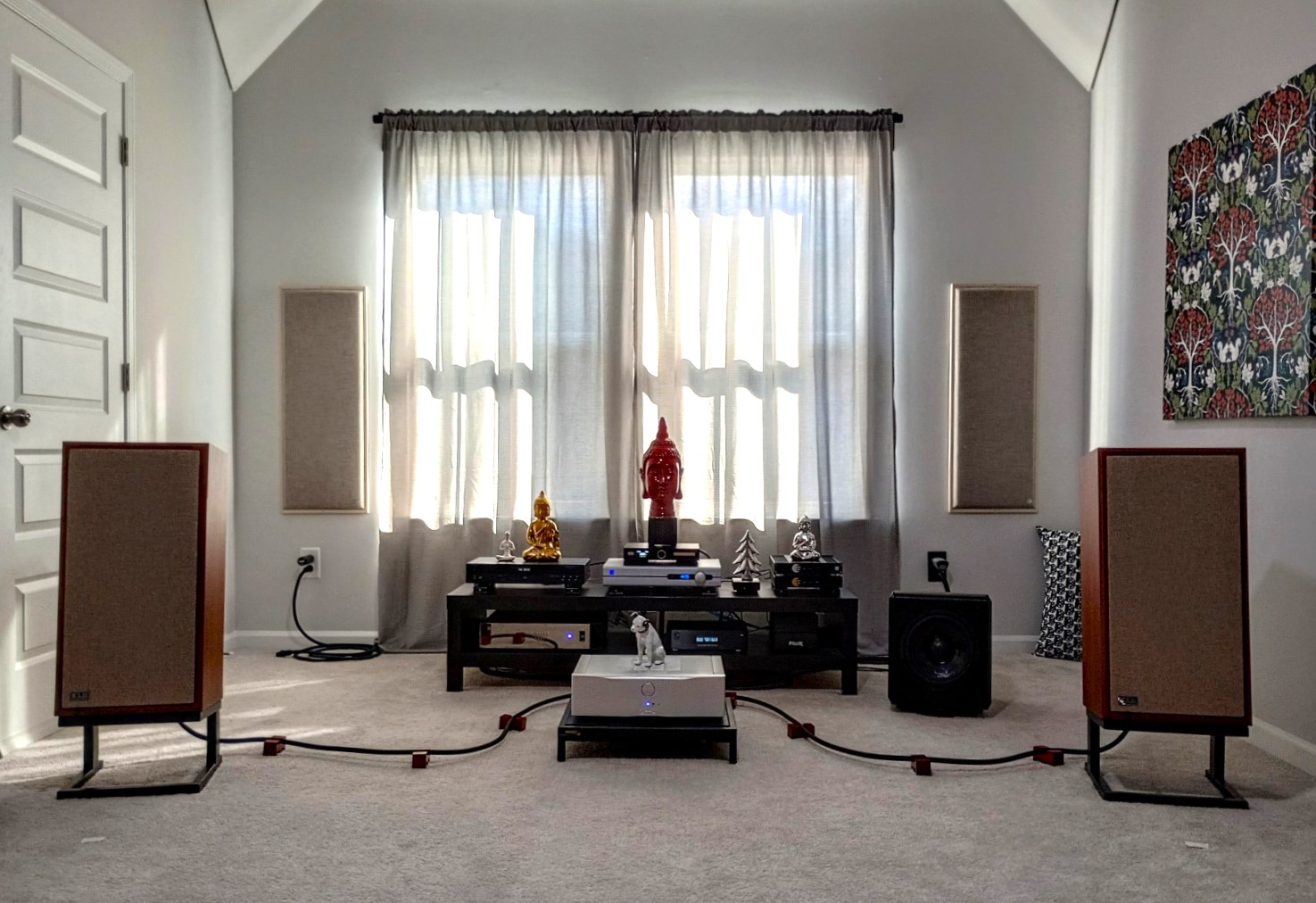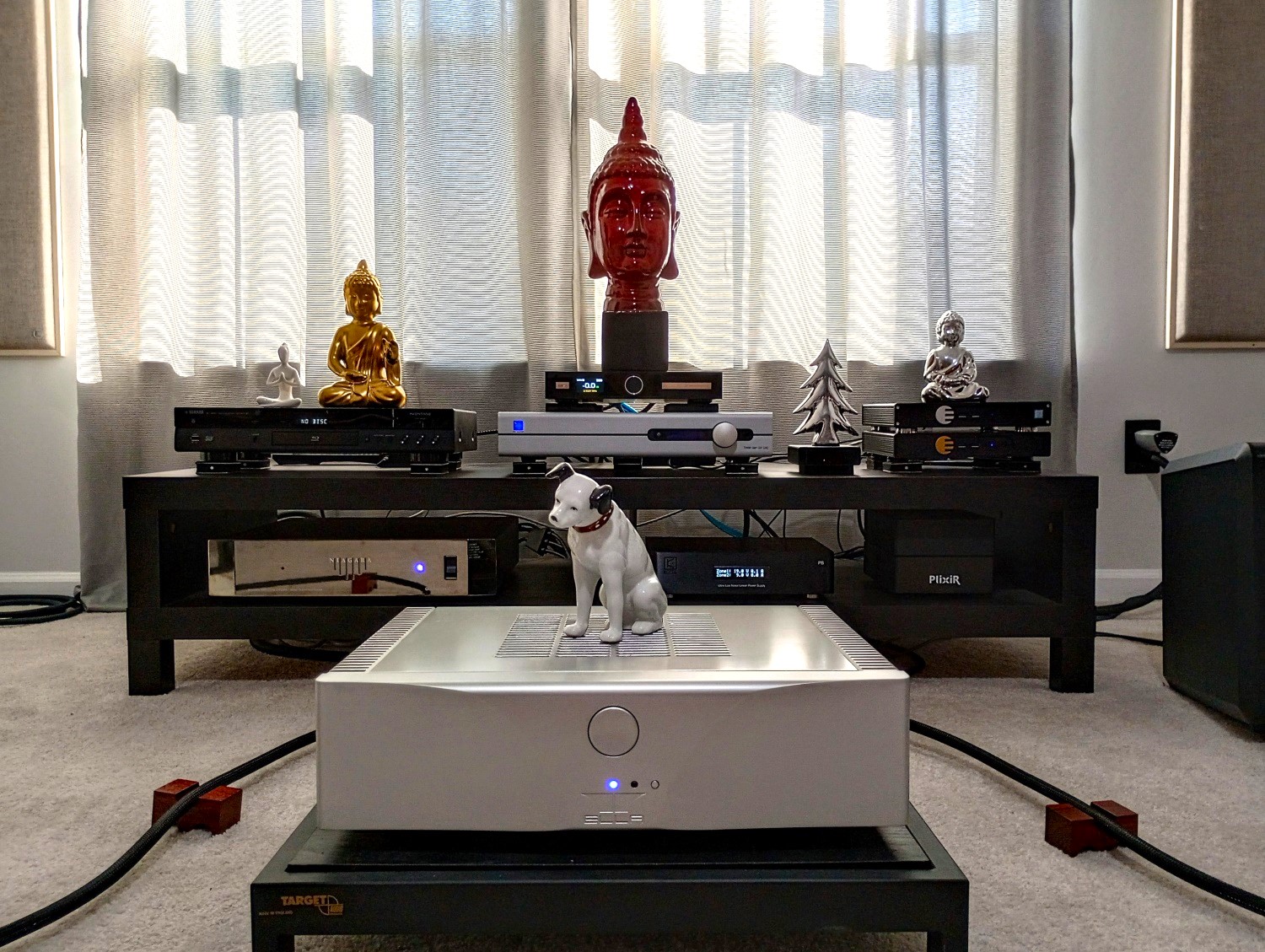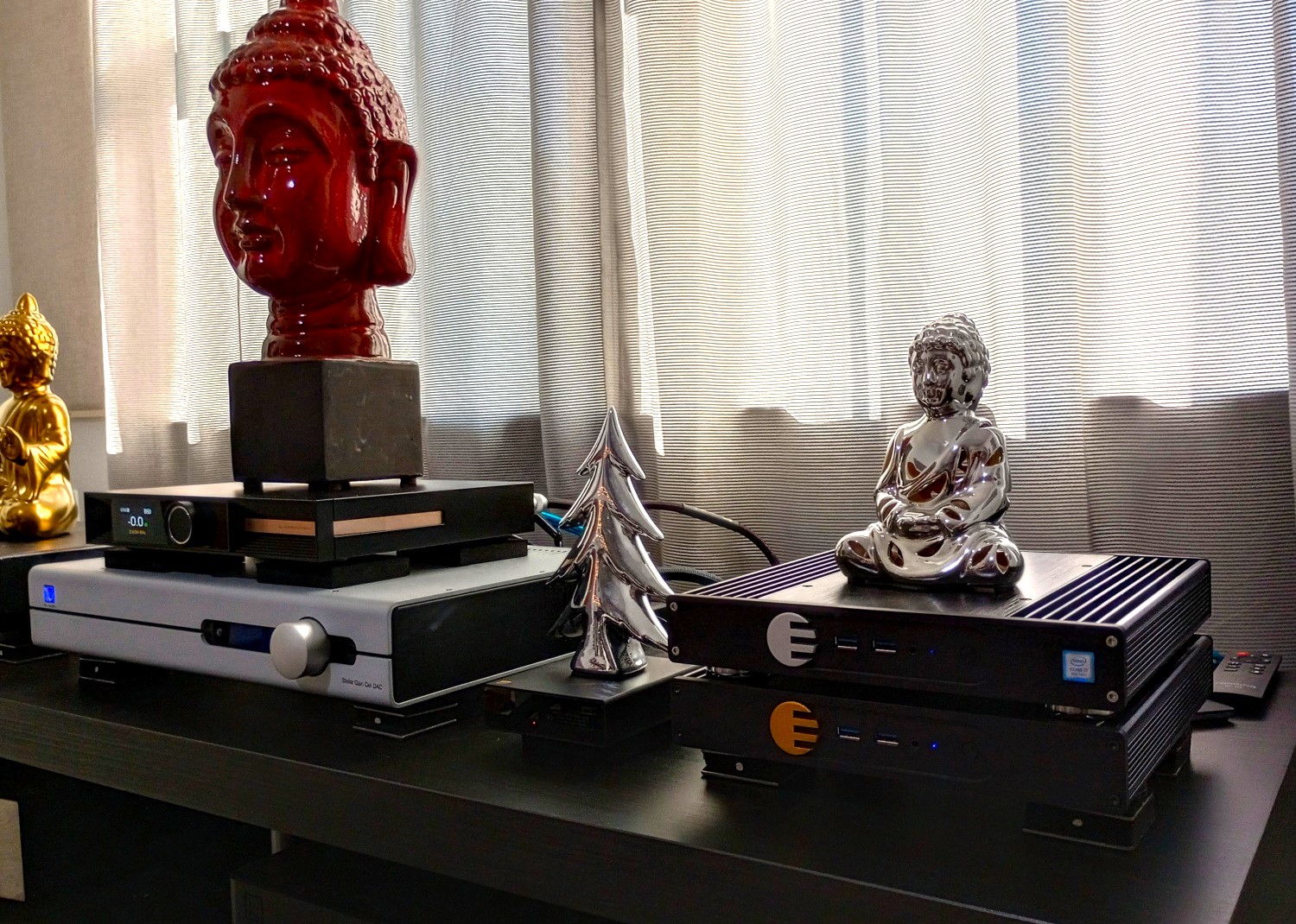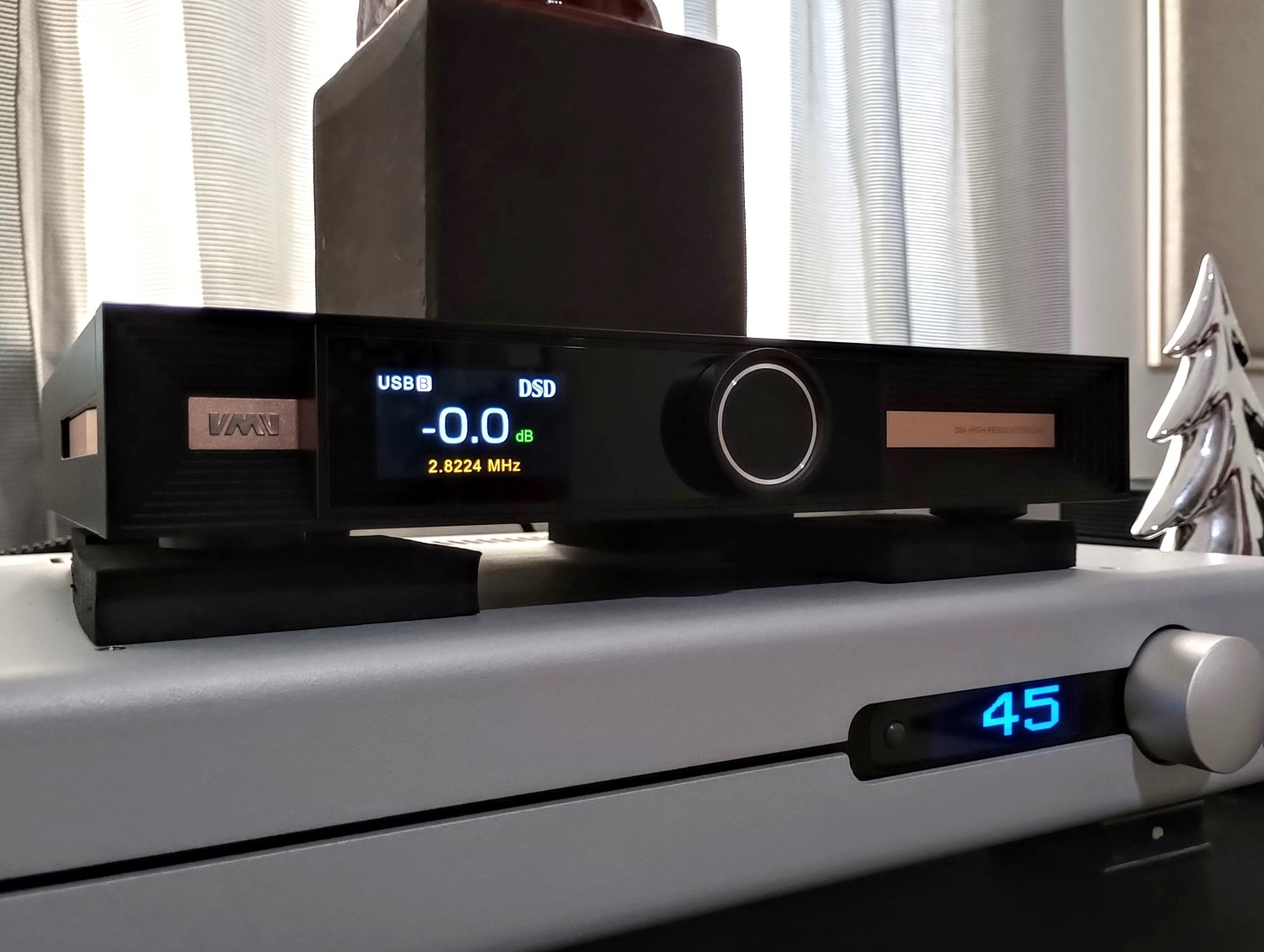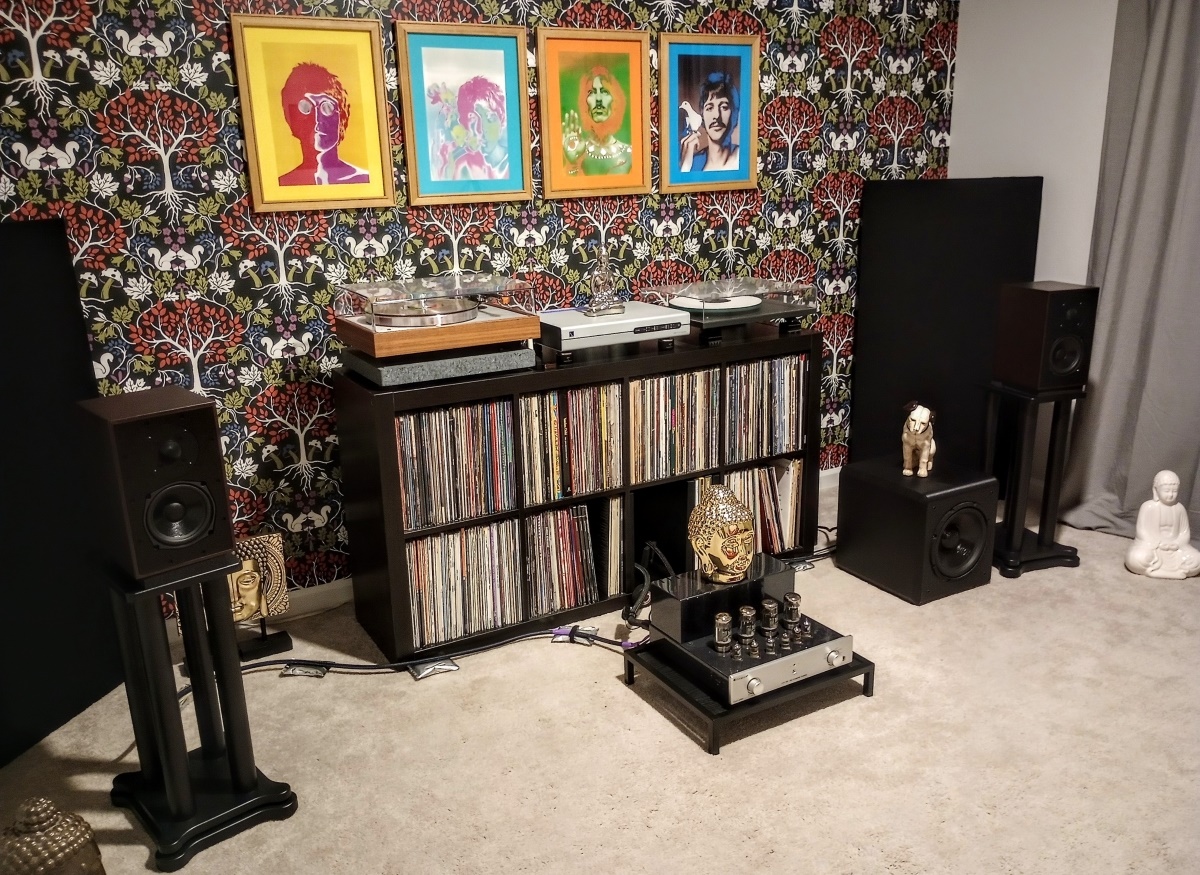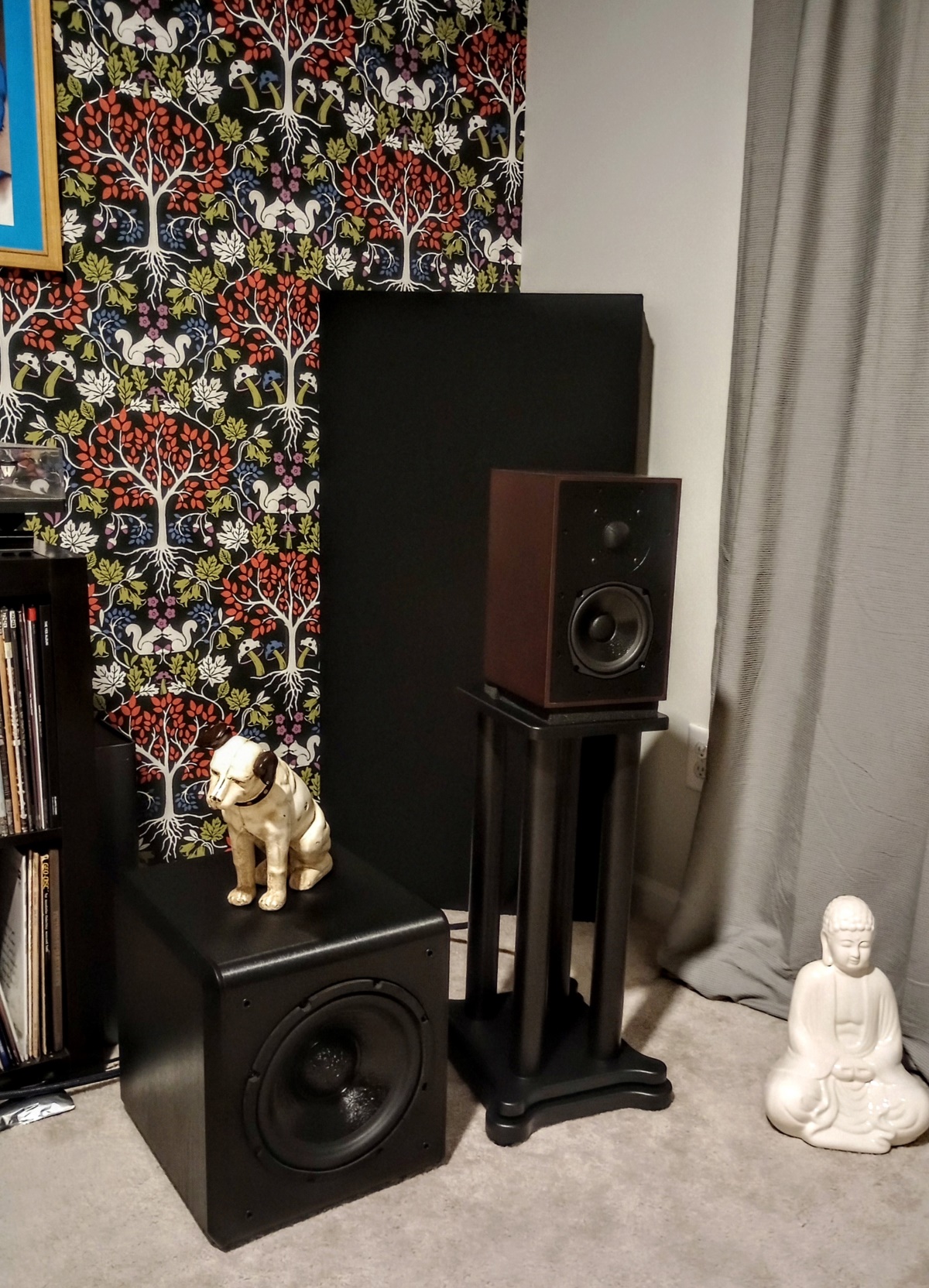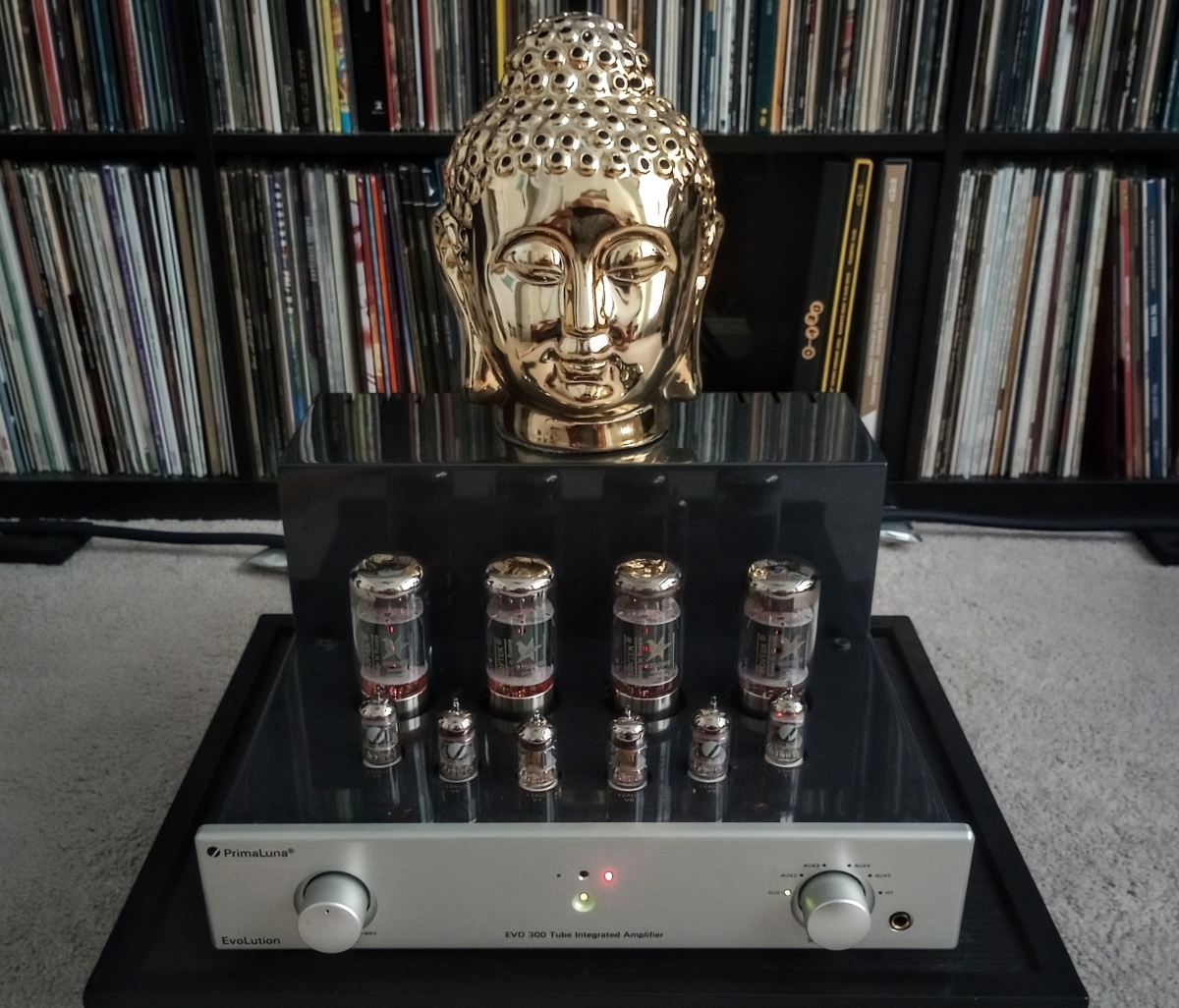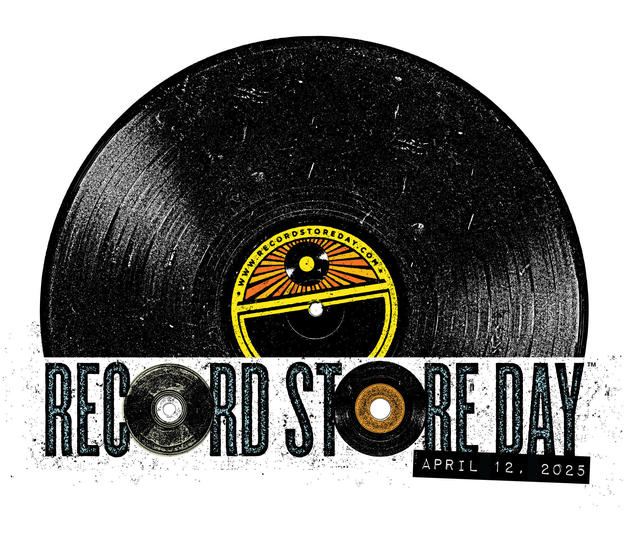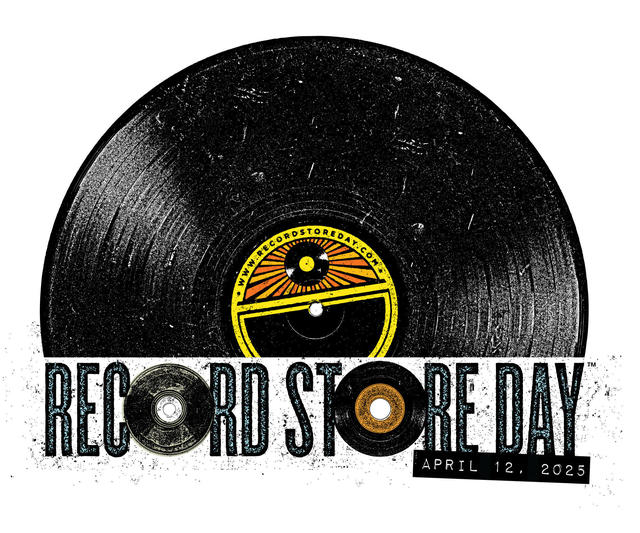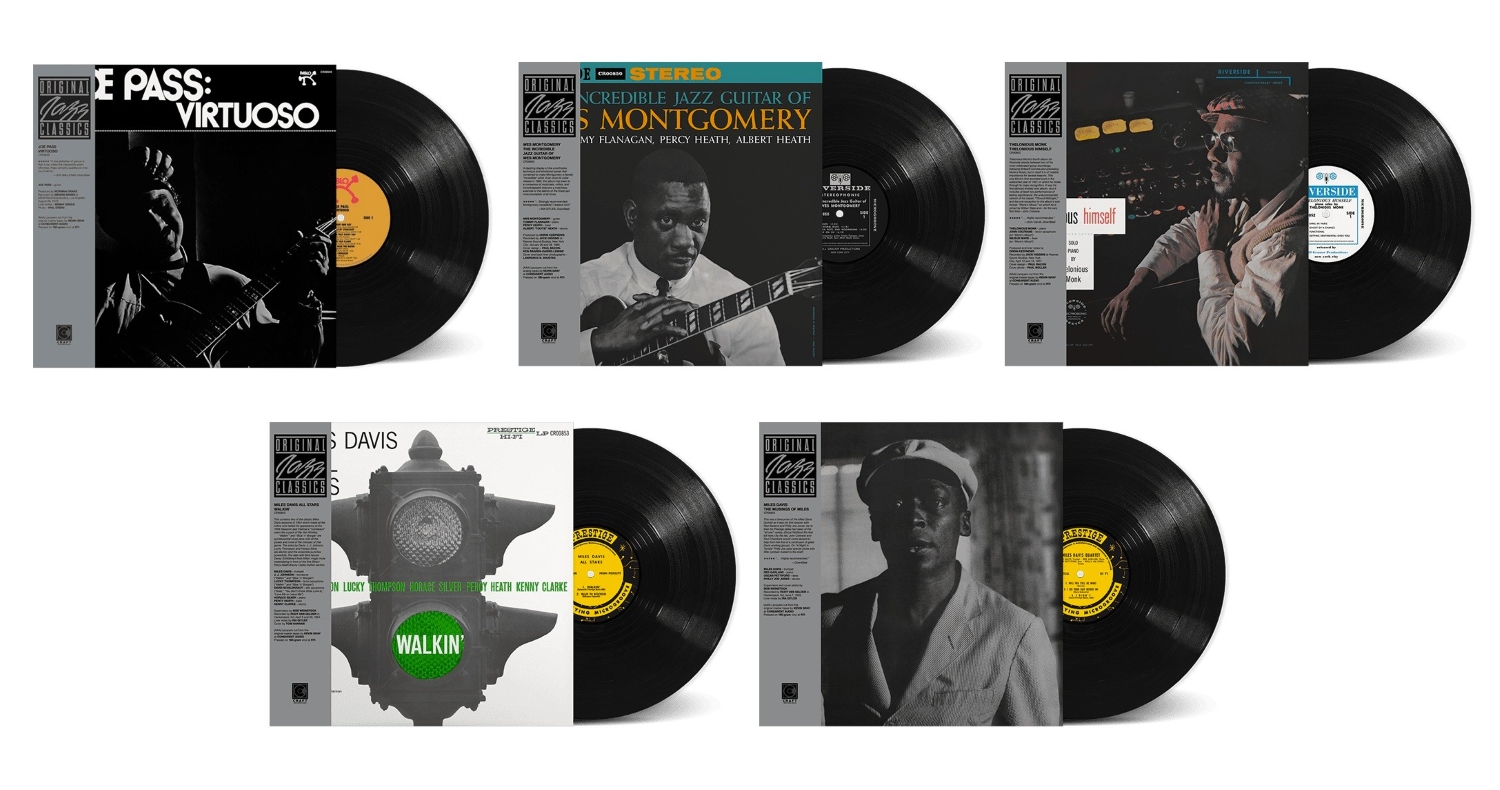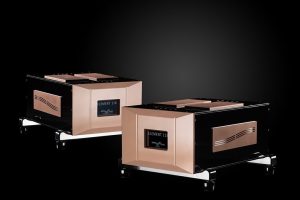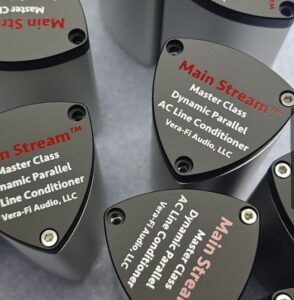Since my move to South Carolina, I've been in the process of slowly refining and (hopefully!) finalizing my seemingly ever-evolving audio systems. With regard to the analog system, the recent addition of the PS Audio Stellar phono preamp has gotten me very close to the end-game for the room. The Stellar has inputs to service two turntables, and its outstanding functionality and superb sound quality have proven it to be the missing link in my pure analog system setup. I couldn't be happier with the outcome, and can't imagine that my enjoyment of LPs could get any better than it currently is.
Because the analog room is smaller than the room that houses the digital equipment and Magneplanar loudspeakers—which need a lot more room to breathe—I seriously played about with the equipment setup and room treatments to achieve great sound. Space is at a premium, and making room for the large Ikea Kallax unit (for record storage) and a dedicated audio equipment rack didn't seem to be working for me, or in the room. Middle of last year, I took a long hard look at the Kallax unit—I've had it for over a decade, and having experienced several moves (and actually dropping it a few times!), it's still functionally perfect. Yeah, it's Ikea, but it's surprisingly, solidly well-made, and heavily robust—maybe it might work for LP storage and equipment in the room. After playing about with positioning for several months, and with the arrival of the Stellar phono preamp, I feel like we're finally there.
The presence of all the LPs in the Kallax unit adds a degree of additional isolation to the equipment that sits on its surface. And despite the relatively close proximity of two turntables and the Stellar phono preamp to the stand-mounted KLH Model Five loudspeakers that flank either side of the unit, nothing noticeably suffered from the setup—even though the bass content of the Model Fives energize the room significantly.
I have a significant level of experience with isolation products from another manufacturer, and I have those devices placed under all the source equipment and the Vanguard Caldera subwoofer in the digital room. As well as under both turntables in the analog room—they're superb isolators and provide excellent protection from vibrations. But when it came to the setup of the Stellar phono preamp, I was at least temporarily strung out in terms of available vibration protection options from the supply closet.
Mark Schifter of Vera-Fi Audio Must be Reading my Mind!
I'm beginning to wonder if perhaps Mark Schifter might be listening to an Alexa feed from my home—it seems like every single time I'm in need of something to solve a potential problem in my audio system, the package is literally already in the mail. He reached out in mid-December to enquire if I'd like to take a listen to a pair of the Puron AC Power Conditioners, and my response was basically like, "Duh! Absolutely!" And the Puron devices are absolutely indispensable—you can read my review of the not-at-all subtle improvements they brought to my audio and video systems HERE. Mark has entrenched himself and Vera-Fi Audio in the presence of audio geniuses who continually crank out products that not only enhance your enjoyment of music and/or video, but are also uber-affordable. It's insane!
Anyway, I got a notification with a tracking number for the Puron devices; about a day later, my USPS daily email showed another package of unknown origin or sender scheduled to arrive in a couple of days. I queried Beth as to whether she was expecting anything—nope, nada. So when the package arrived, lo and behold, and it was from Vera-Fi Audio, my first response was "What's Mark got up his sleeve now?" Opening it revealed a four pack of VBH-1 Vibration Black Hole Isolation Feet—hey, I have the perfect place for these guys!
VBH-1 Vibration Black Hole Isolation Feet
Like most Vera-Fi products, the VBH-1 isolation feet arrived in nondescript packaging; they also came without setup instructions, but you can find more detailed information at Vera-Fi's website. Also there was no information about the country of origin, although I was able to confirm from Mark that the metal parts of the VBH-1 are fabricated in China, but final assembly of each is done here in Robinson, Illinois, in the USA. Anyway, inside the box are four jewel-like assemblies; the main bases are housed in satin-black metal cases with a stainless steel cap and are imprinted with the VBH-1 logo. The box also contains four black-and bronze finished metal "tiptoe-like" devices designed to sit on top of the base and underneath your equipment's chassis. The package also contains a sheet of round adhesive dots that help secure the tiptoe-like devices to the underside of the chassis; your equipment then simply sits on the VBH-1 bases in your desired location.
Each VBH-1 base has a large-diameter silicone rubber O-ring on its underside to protect surfaces and prevent the assembly from bottoming out from the weight of the equipment resting on them. Each base also contains multiple, alternating layers of nylon, stainless steel, viscous polymer, and silicone rubber in a dissimilar materials configuration that's designed to provide mechanical damping between themselves and the equipment that rests on them. Each VBH-1 is rated to handle a load of 30 lbs, so a set of four can support up to 120 lbs. The VBH-1 isolation feet can be used with any type of audio equipment, and also can be used with loudspeakers; their design seems to suggest that they'd be most effective on hard surfaces, like equipment rack shelves or hard-surface flooring for use under loudspeakers, etc. My intended location for them was underneath the PS Audio Stellar phono preamp, which should benefit from the additional isolation.
The VBH-1 isolation feet employ a constrained viscous layer damping (CVLD) technique that's remarkably similar to isolators from other manufacturers, which also are based on the same technology. There's one huge difference here—whereas the other isolators are very effective at reducing airborne and surface vibrations, they're also rather utilitarian in appearance. Not that their appearance is an issue for me; I'm much more interested in how a particular device works for its intended purpose than how it looks. That said, the Vera-Fi VBH-1 devices are very elegant in appearance, and are perhaps the most stylish looking isolation devices I've ever had the pleasure of incorporating in any of my audio systems!
Setup of the VBH-1 Isolation Feet
While I typically seem bent on placing isolation footers underneath the existing feet of any particular piece of equipment, that didn't seem to be the order of the day with the VBH-1 devices. Which would not remain attached to the existing feet, no matter how I tried—the adhesive dots kept slipping off the rubber footers of the Stellar phono pre. After about an hour of consternation, I came to my senses and simply attached the adhesive dotted tiptoe-like portion of the VBH-1 directly to the underside of the Stellar's chassis. This worked perfectly, and because each VBH-1 is capable of supporting up to 30 lbs., I ended up placing them in a tripod-like configuration underneath the Stellar unit. Using an odd-number of footers is an old-school audio approach, but hey—whatever works.
I also later saw a Facebook post to Mark Schifter asking about just placing the existing equipment feet directly on the VBH-1 bases, and whether that would yield any benefit. Mark's response was yes, that was a perfectly reasonable approach, and that the viscous damping from the base would provide almost the same level of vibration reduction as using the entire system. Good to know, although I'm not completely certain I'd have taken that approach, even if I'd known it was an option an hour earlier!
As I previously mentioned, the Ikea Kallax unit serves as the base station for both turntables and the Stellar phono preamp. The Kallax is made from solid MDF panels, along with larger MDF panels that are hollow. The entire unit been veneered with some kind of wood-grained vinyl covering; I have no idea if any cross-bracing is used in the hollow panels. That said, it's a substantial piece of furniture for around $100, and has been dragged through several moves and survived unscathed. With much of my LP collection adding ballast to it, it's very heavy, and doesn't seem excessively vibration prone, even with the pair of new production KLH Model Five loudspeakers flanking it. And the Model Fives energize the room significantly; even though their low-bass cutoff is around 42Hz, their in-room bass down point is probably closer to 30-35Hz. That's enough to seriously shake anything that's within a few feet of them, including both turntables and the phono preamp.
I also have a pair of GIK Acoustics bass traps in the corners behind the KLH Model Fives, as well as ASC panels scattered around the room. The heavier ProJect Classic EVO turntable is sitting on a Bright Star Audio sand-filled isolation base—its weight definitely adds some additional ballast to the Kallax unit. I wish I'd gotten a pair of the Bright Star bases—this one is probably 30 years old, and while Bright Star appears to still be in business, they no longer make the sand-filled bases. The Classic EVO table sits on three isolators that are perched underneath its captive footers; the Rega P2 table is fitted with adjustable isolation feet from Tango Spinner, and those sit on a trio of isolators as well. The Stellar phono preamp is mounted on the VBH-1 isolation feet and sits between the two turntables; my PrimaLuna EVO 300 tube integrated amplifier now sits on the floor in front of the whole shebang on a Target amp stand.
Impressions
Just for clarity: unlike so many devices that can be plugged/unplugged or inserted and removed for instant A/B comparison, the VBH-1 devices do not lend themselves to such easy evaluations. My approach to measuring their effectiveness was based on how they isolated the PS Audio Stellar phono preamp from surface and airborne vibrations, and also on my recollection of the sound of recent LPs I'd played prior to the insertion of the VBH-1 isolators into the playback chain. It is what it is. I played stereo LPs on the ProJect Classic EVO turntable; the Rega turntable is fitted for mono playback.
An album I reviewed prior to the arrival of the PS Audio Stellar unit and the VBH-1 isolators was Impex Records' 180 gram LP reissue of Jennifer Warnes' The Hunter, which is an album filled with seriously dynamic contrasts and subterranean levels of deep bass. You can read my full review HERE, but the track in particular I'd like to reference is the tune "Way Down Deep," which nearly destroyed my audio setup from around a decade earlier. The track features crushing talking drum whacks from percussionist Lenny Castro, while Jorge Calderon's almost unearthly bass rumbles like a subway racing through the room—this is a torture track that will challenge any system. In my initial review—even minus the uptick in sound quality I've gained from the Stellar—my evaluation of the LP revealed playback that was effortless and very musical.
With the new equipment in place, the first step was to check the system's response to vibrations—this yielded very important clues to how the VBH-1 devices compared to the other isolators I've been using daily for five years. As the opening salvo of drum whacks from "Way Down Deep" filled the air, I first placed my hands on the top of the Kallax unit, which of course vibrated as expected with the Model Fives so close. Even at the point of the music's peak intensity, the turntables—which were fitted with isolators from another manufacturer—showed no sign of vibrations. Placing my hand on either turntable's plinth showed no vibration, whether surface or airborne. I've known for years that my current isolators are superior devices—they control vibrations with a level of effectiveness that belie their pedestrian appearance.
So here's the real-world test of the VBH-1 isolators, and based on my experience with Mark Schifter and Vera-Fi's products, I wouldn't have expected anything less: the PS Audio Stellar unit also was completely vibration-free, even at the dynamic peak of "Way Down Deep." Despite playing this "acid test" track for deep bass and challenging dynamics, the Stellar phono preamp was totally free from any mechanical vibrations transmitted from the Kallax's surface or from any airborne vibrations from the KLH Model Fives. Here's the part I wasn't completely expecting: the music from this demanding track was presented with an ease and effortlessness that enhanced its musical presentation in every way possible compared to my original evaluation. Jennifer Warnes' voice was more colorful and liquidly rendered, the already deep bass was even more controlled, and the track's nearly unrestrained dynamics seemed more emotionally powerful than ever before. I mean—and quite literally—damn! I've relistened to the entire album, and I probably should do an update to my original review to let the guys at Impex Records know how I really feel about their new reissue!
Every LP I've played from the point the VBH1 isolators were inserted in my system, every album I've evaluated for review, every LP I've purchased for my own collection has been rendered with a level of improved fidelity that I would have previously only have attributed to the presence of the PS Audio Stellar phono preamp. Its inclusion has led to a phenomenal improvement to my analog playback, there's no doubt about that. But the enhanced retrieval of detail, deeper and more controlled bass, and improved microdynamics that have had such a positive impact on the overall musicality of my analog system has to account for the VBH-1 isolators as part of the equation. I've been hearing this in all my LP listening for the last month or so; sure there have been a few lemons, like the awful, awful new UMG pressing of Tom Waits' Swordfishtrombones—that sort of thing goes with the territory. But other albums I've recently acquired, like the Kate Bush Fish People label catalog reissues, or the Kraftwerk German original pressings (one word: Wow!)—are rendered with a level of fidelity that simply shocks me with its goodness. This kind of thing shouldn't surprise me that much; I've been experiencing overall improvements in my digital system for several years now with the addition of viscous layered damping devices.
Final Thoughts
Most isolation devices are designed to reduce vibrations to the affected equipment; reducing those vibrations improves your music playback by increasing microdynamics and reducing temporal smear. Prior to about five years ago, I'd never given much thought to vibration effects on audio equipment that simply sits on a rack. With the exception of turntables, which can obviously benefit from some type of vibrational damping. However, I've long since seen the light, and have reached the realization that all equipment can benefit from vibration control, regardless of how insignificant that piece of equipment might outwardly seem.
The Vibration Black Hole isolators, plainly and simply, accomplish what they're designed to do, period. The careful lengths I'd previously gone to by reducing vibrations to my turntables seems to have vanquished those effects from my LP playback—which even without any vibration protection underneath the Stellar phono preamp was probably "good enough" in my opinion. The arrival of the VBH-1 devices proved to me how very wrong I was—good enough often isn't very good, after all! I've already scoped out the next area for improvement in the analog room: my PrimaLuna tube amplifier simply sits on its Target amp stand. Yeah, it weighs 80 lbs, but those delicate bottles would very likely benefit from some VBH-1-type vibration control!
Vera-Fi's VBH-1 devices are elegantly stylish in appearance, will complement any high-end audio system with their excellent performance, and get you even closer to the music. All of Mark Schifter and Vera-Fi's products are based on an exceptional level of science; they're designed to cut through all the crap between you and your music, and isn't that what it's really all about? The VBH-1 isolators work as well—or better—than the more utilitarian-looking, viscous layered damped isolation devices from other manufacturers. And I can't emphasize how much of a bargain the VBH-1 isolators are—they retail for less than half the current price of similar designs. Once again, well done Mark! The VBH-1 Vibration Black Hole Isolation Feet come very highly recommended!
VBH-1 Vibration Black Hole Isolation Feet
Retail: $199 MSRP (Pack of 4)
Vera-Fi Audio
All photos courtesy of Vera-Fi and the author













